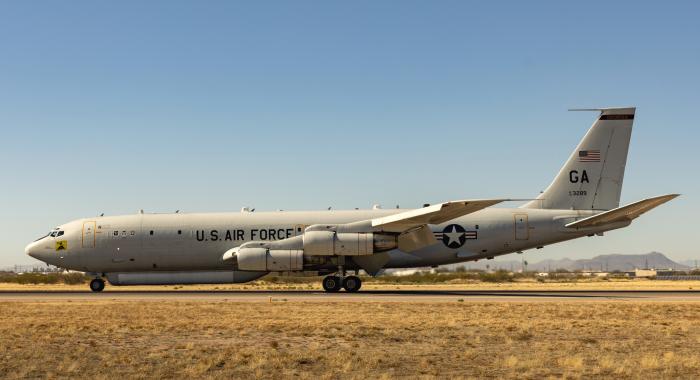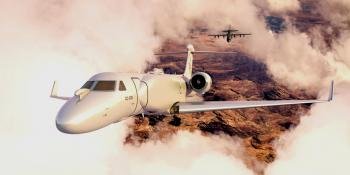RETIREMENT OF the US Air Force’s fleet of 16 E-8C Joint Surveillance Target Attack Radar System (JSTARS) aircraft officially got underway on February 10, when the first of these aircraft departed from its home at Robins Air Force, Base, Georgia, for the final time. The aircraft, serial number 92-3289 ‘GA’ with ‘The Rattler’/‘Don’t tread on me’ nose art, which had been the first to arrive at Robins in 1996, left on its final flight for storage with the 309th Aerospace Maintenance and Regeneration Group (AMARG) at Davis-Monthan AFB, Arizona. It arrived at AMARG the following day.

These aircraft are operated by the Georgia Air National Guard’s 116th Air Control Wing (ACW) and its active duty associate 461st ACW. Col Amy Holbeck, commander of the 116th Air Control Wing, said: “The first retirement of a JSTARS aircraft gives us an opportunity to celebrate the operational accomplishments and the pivotal role the aircraft has played since the first one came to Robins in 1996.”
In 2018, then Secretary of the Air Force Heather Wilson announced the airframe was not to be recapitalized. In late 2021, Gen. Charles Q Brown, Jr., the chief of staff of the Air Force, signed an official memorandum to begin the divestment of Joint STARS in fiscal year 2022. On December 21 last year it was officially announced that divestment of the fleet would begin with retirement of the first four aircraft in fiscal year 2022.
Aircraft 92-3289 didn’t begin as an Air Force E-8C. Surprisingly enough, it began as a passenger Boeing 707 airliner with Qantas Airways in 1968. Ownership was transferred a few times before eventually being purchased by Grumman Melbourne Systems Division, for its conversion into the current E-8C. After conversion, it was officially delivered to Robins AFB in March 1996.
Retired Col Henry Cyr, manned C2-ISR programs director for Northrop Grumman and former 461st Air Control Wing commander, said: “Northrop Grumman employees converted an airliner to a military weapon system, modifying the aircraft and installing state of the art technology that would deliver unparalleled awareness on battlefields around the globe.”
The 93rd Air Control Wing, which activated on January 29, 1996, accepted 92-3289 that June and deployed in support of Operation Joint Endeavor in October. Aircraft 92-3289 and a pre-production E-8C flew almost 40 operational sorties and almost 500 flight hours. Operation Allied Force saw Joint STARS in action again from February to June 1999 accumulating more than 1,000 flight hours and a 94.5% mission-effectiveness rate in support of the Kosovo War.
In addition to Operations Allied Force and Operation Joint Endeavor, E-8C Joint STARS have been involved in NATO operations Enduring Freedom, Iraqi Freedom and Inherent Resolve, as well as various counter-narcotics missions. Since 9/11, the E-8C fleet has flown more than 130,000 combat mission hours.
“From the beginning, JSTARS was an immediate game changer on the battlefield and the resulting successes have been impressive,” Holbeck said. “We will continue to provide support to the combatant commanders until the last aircraft has been divested.”
“The E-8C JSTARS have been invaluable to the joint force by using cutting-edge technology throughout their 20 years of service,” said Col Michelle Carns, commander of the 461st Air Control Wing. “Our Airmen will continue to provide that same level of support to the mid- 2020s.”
The USAF retirement of the Joint STARS aircraft will allow airmen at Robins to transition to four new missions coming to the base. Those new missions include the Advanced Battle Management System Family of Systems, an intelligence-gathering network under development that allows real-time sharing of battlefield information between satellites in space, military aircraft, ground forces and commanders. The other three missions include an E-11A Battlefield Airborne Communication Node squadron, a Spectrum Warfare Group and a Battle Management Command and Control unit.
“The retirement of aircraft 92-3289 is bittersweet as it represents the beginning of the divestment of the E-8C fleet but it also is an opportunity to reflect on the great good that can come from a military and industry team focused on delivering what is needed in the defence of our nation,” Cyr said.
Although 92-3289 is the first of the current fleet to retire, it was not the first E-8C to go into storage at AMARG. The desert storage facility also holds E-8C 90-0175, which had previously been used by Northrop Grumman as a development and trials aircraft but retired to AMARG on January 21, 2015.





